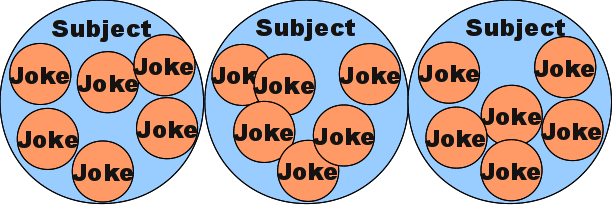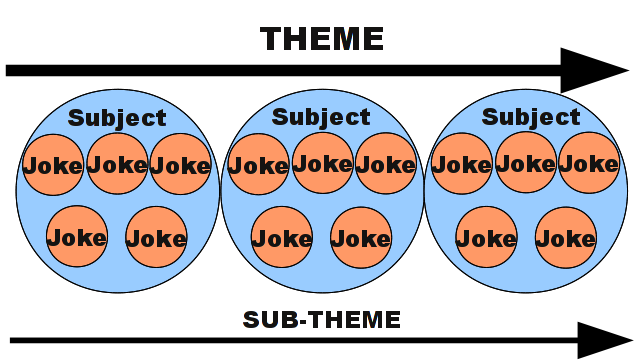Structuring a Show
Posted on 05 May 2011
If you have been haunting open mic nights for some time, you may feel it’s time you try your hand at a full-length show. Now certainly you can take a few intervening steps. Doing a group show with your mates is a good start. However, at some point you will want to create something that’s all your baby. In that case you will need to think about how to structure your comedy.
Comedy is an art of constant refinement. You write a joke, you tell a joke, you gauge people’s reactions, you rewrite it, then try the joke again and do more gauging. It can take some time to develop five minutes of solid material. Developing an hour’s worth of show can feel like a Herculean task. Add to that remembering all you have written and still being able to interact with the audience.
Having something around which you can structure your show can make the process easier. It all becomes more paint-by-numbers. It also makes your show more memorable.
Bags O’ Jokes
The most common structure for the beginner is bringing together all the jokes they’ve told so far and gathering them under a few subject headings (our bags o’ jokes). Often the jokes in one bag are only loosely related to one another. The subjects themselves may not be related at all. You could be hopping from relationships, to dogs, to the latest news item.
Various long time professionals use this structure and are successful with it. However, you will have to work harder to keep the laughs steady and to ensure people remember what you have said well enough to spread the news. Structure is a mnemonic device: the more structure, the easier to recall for both you and the audience.
Adding Theme
I highly recommend comedians give their show a theme. This gives their jokes direction. It also makes the show more marketable.
When you have a theme, you select subjects that are related to that theme. The jokes within each subject generally must also be related to the theme or get thrown out. You can also think about placing your best joke within each subject near the end of that set, and the best group of jokes at the end of the show.
For instance your theme could be about how you have troubles finding the right partner. Your first subject could be about using online dating sites, your next subject could be about the dates, and your final subject could be about when things get serious.
Relationships is a subject everyone understands. You can easily create a logical and focussed trajectory through your jokes. Your audience will anticipate your next step, generating excitement. This doesn’t mean you won’t be throwing in twists and turns and plenty of surprises. In fact their very anticipation makes such surprises simpler to build into your show.
The marketing side comes in because with your theme you can start creating advertising images that reinforce what your show is about and attract audience. People may be interested in your humour, but if it’s your humour AND it’s about something that interests them such as vampires, you’ve given them extra reason to dust your seats with their tail-feathers. Your theme will also find you media outlets for promoting your show. If your theme is about DIY disasters, then magazines about plumbing, carpentry, and carpet laying may all be interested in what you are up to.
Sub-theme
Sub-themes aren’t neccessary, but they do enrich a show and keep it from getting overly simplistic. Audiences love the interplay of minor and major characters. They love experiencing how parallel constructions will ultimately impact upon one another.
Let’s say your relationships show focusses primarily on your dating experiences and finally finding the perfect date. If you are a male comedian, perhaps you then also talk about your sister’s dating experience. This would be the sub-theme. Your jokes could then compare and contrast your two experiences, making various humorous observations possible.
Story shows
A story show will require loads of structure.
You will have to have a beginning (if this set of circumstance and this inciting event), a middle (then these things will happen creating more and more tension), and an end (resulting in a climactic event and these consequences). Freytag’s pyramid is one of the early descriptions of this dynamic. Your theme gives your story focus, but now plot drives the characters’s actions to a conclusion for us to consider.
Unique to live comedy, though, is a lack or foreshortening of denouement. The final punchline or capper is going to complete the story in one defining moment, without any further time to wrap up loose ends.
In our brother/sister dating show you might make them highly competitive. They might make a bet as to who can get to third base fastest with a new love interest. Situations get more and more tense as they try to outdo one another and impress their dates. Inevitably both of their stories will need to collide by the end of your show ending things in disaster and generating laughs.
A story is utterly memorable. It can potentially keep your audience at the edge of their seats, give them jokes at which to laugh, characters to love and hate, and an interesting tale. Storytelling is no easy task and requires considerable skill. Done successfully it’s immensely satisfying.
Remember that all these structures are merely tools. The one that works for you is completely legitimate. The laughs are what counts. I would say that it’s worthwhile playing around with each before settling into the one that suits your style. Do not confuse lack of experience with lack of ability in your choice. Mostly, as always, have fun.
Peace and kindness,
Katherine
Responses are closed for this post.





